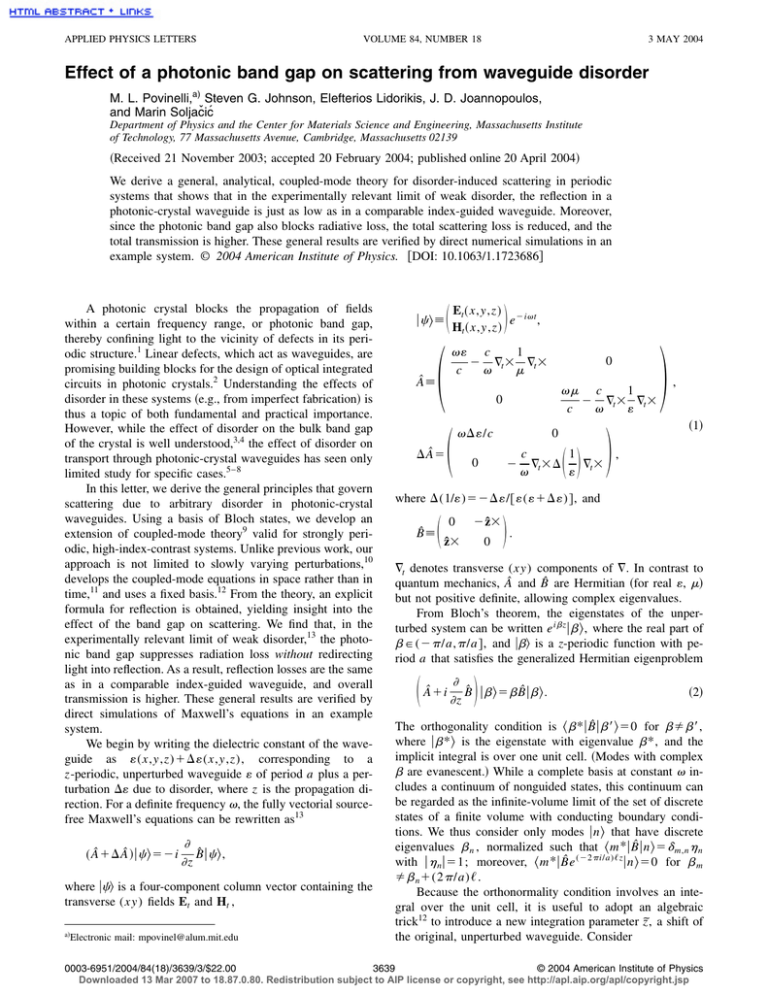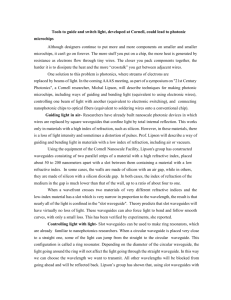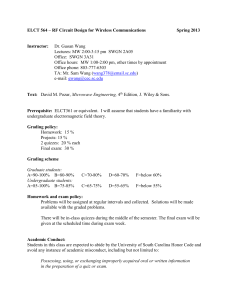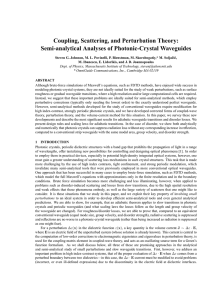Document 10494984
advertisement

APPLIED PHYSICS LETTERS VOLUME 84, NUMBER 18 3 MAY 2004 Effect of a photonic band gap on scattering from waveguide disorder M. L. Povinelli,a) Steven G. Johnson, Elefterios Lidorikis, J. D. Joannopoulos, and Marin Soljačić Department of Physics and the Center for Materials Science and Engineering, Massachusetts Institute of Technology, 77 Massachusetts Avenue, Cambridge, Massachusetts 02139 共Received 21 November 2003; accepted 20 February 2004; published online 20 April 2004兲 We derive a general, analytical, coupled-mode theory for disorder-induced scattering in periodic systems that shows that in the experimentally relevant limit of weak disorder, the reflection in a photonic-crystal waveguide is just as low as in a comparable index-guided waveguide. Moreover, since the photonic band gap also blocks radiative loss, the total scattering loss is reduced, and the total transmission is higher. These general results are verified by direct numerical simulations in an example system. © 2004 American Institute of Physics. 关DOI: 10.1063/1.1723686兴 A photonic crystal blocks the propagation of fields within a certain frequency range, or photonic band gap, thereby confining light to the vicinity of defects in its periodic structure.1 Linear defects, which act as waveguides, are promising building blocks for the design of optical integrated circuits in photonic crystals.2 Understanding the effects of disorder in these systems 共e.g., from imperfect fabrication兲 is thus a topic of both fundamental and practical importance. However, while the effect of disorder on the bulk band gap of the crystal is well understood,3,4 the effect of disorder on transport through photonic-crystal waveguides has seen only limited study for specific cases.5– 8 In this letter, we derive the general principles that govern scattering due to arbitrary disorder in photonic-crystal waveguides. Using a basis of Bloch states, we develop an extension of coupled-mode theory9 valid for strongly periodic, high-index-contrast systems. Unlike previous work, our approach is not limited to slowly varying perturbations,10 develops the coupled-mode equations in space rather than in time,11 and uses a fixed basis.12 From the theory, an explicit formula for reflection is obtained, yielding insight into the effect of the band gap on scattering. We find that, in the experimentally relevant limit of weak disorder,13 the photonic band gap suppresses radiation loss without redirecting light into reflection. As a result, reflection losses are the same as in a comparable index-guided waveguide, and overall transmission is higher. These general results are verified by direct simulations of Maxwell’s equations in an example system. We begin by writing the dielectric constant of the waveguide as (x,y,z)⫹⌬(x,y,z), corresponding to a z-periodic, unperturbed waveguide of period a plus a perturbation ⌬ due to disorder, where z is the propagation direction. For a definite frequency , the fully vectorial sourcefree Maxwell’s equations can be rewritten as13 共 Â⫹⌬Â 兲 兩 典 ⫽⫺i B̂ 兩 典 , z where 兩典 is a four-component column vector containing the transverse (xy) fields Et and Ht , a兲 Electronic mail: mpovinel@alum.mit.edu 兩典⬅ Â⬅ 冉 冉 ⌬Â⫽ 冊 Et 共 x,y,z 兲 ⫺i t e , Ht 共 x,y,z 兲 1 c ⫺ ⵜt ⫻ ⵜt ⫻ c 0 0 1 c ⫺ ⵜt ⫻ ⵜt ⫻ c 冉 ⌬/c 0 ⫺ 0 冉冊 冊 冊 , 共1兲 1 c , ⵜ ⫻⌬ ⵜ⫻ t t where ⌬(1/)⫽⫺⌬/ 关 (⫹⌬) 兴 , and B̂⬅ 冉 0 ⫺ẑ⫻ ẑ⫻ 0 冊 . ⵜt denotes transverse (xy) components of ⵜ. In contrast to quantum mechanics, Â and B̂ are Hermitian 共for real , 兲 but not positive definite, allowing complex eigenvalues. From Bloch’s theorem, the eigenstates of the unperturbed system can be written e i  z 兩  典 , where the real part of  苸(⫺ /a, /a 兴 , and 兩典 is a z-periodic function with period a that satisfies the generalized Hermitian eigenproblem 冉 Â⫹i 冊 B̂ 兩  典 ⫽  B̂ 兩  典 . z 共2兲 The orthogonality condition is 具  * 兩 B̂ 兩  ⬘ 典 ⫽0 for  ⫽  ⬘ , where 兩  * 典 is the eigenstate with eigenvalue  * , and the implicit integral is over one unit cell. 共Modes with complex  are evanescent.兲 While a complete basis at constant includes a continuum of nonguided states, this continuum can be regarded as the infinite-volume limit of the set of discrete states of a finite volume with conducting boundary conditions. We thus consider only modes 兩 n 典 that have discrete eigenvalues  n , normalized such that 具 m * 兩 B̂ 兩 n 典 ⫽ ␦ m,n n with 兩 n 兩 ⫽1; moreover, 具 m * 兩 B̂e (⫺2 i/a)ᐉz 兩 n 典 ⫽0 for  m ⫽  n ⫹(2 /a)ᐉ. Because the orthonormality condition involves an integral over the unit cell, it is useful to adopt an algebraic trick12 to introduce a new integration parameter z̃, a shift of the original, unperturbed waveguide. Consider 0003-6951/2004/84(18)/3639/3/$22.00 3639 © 2004 American Institute of Physics Downloaded 13 Mar 2007 to 18.87.0.80. Redistribution subject to AIP license or copyright, see http://apl.aip.org/apl/copyright.jsp 3640 Appl. Phys. Lett., Vol. 84, No. 18, 3 May 2004 Povinelli et al. FIG. 2. Closeup of central waveguide region, showing how identical surface roughness was added to the photonic-crystal and index-guided waveguides. c r 共 z 兲 ⬇⫺i 冉 兺k 冕 dz e i(2  i ⫺2 k/a)z 冕 dx⬘ e 2 ikz ⬘ /a c ⫻ ⌬ 共 x⬘t ,z 兲 Ert 共 x⬘ 兲 * "Eit 共 x⬘ 兲 ⫺⌬ FIG. 1. 共Color兲 共a兲 Waveguide geometries and mode profiles for ⫽0.31(2 c/a). Mode profiles show the electric field component perpendicular to the page; red and blue indicate negative and positive values, respectively. 共b兲 Band diagram for the waveguides shown in 共a兲. Shaded regions indicate extended TM states of the bulk 2D photonic crystal. 共 Â 共 z⫹z̃ 兲 ⫹⌬Â 兲 兩 典 z̃ ⫽⫺i B̂ 兩 典 z̃ , z 共3兲 where Â(z⫹z̃) is obtained by sending ⑀ (x,y,z)→ ⑀ (x,y,z ⫹z̃) in Eq. 共1兲. The solution of Eq. 共3兲 can be expanded as 兩 共 z 兲 典 z̃ ⫽ 兺n c n共 z,z̃ 兲 兩 n 共 z⫹z̃ 兲 典 e i  z . 共4兲 n Since Â(z⫹z̃⫹a)⫽Â(z⫹z̃), the c n ’s can be chosen to be periodic in z̃ and expressed as a Fourier series: c n 共 z,z̃ 兲 ⫽ 兺ᐉ c n,ᐉ共 z 兲 e ⫺2 iᐉz̃/a . 共5兲 After substituting Eq. 共4兲 into Eq. 共3兲, using a shifted version of Eq. 共2兲 for the shifted, unperturbed eigenstates 兩 n(z ⫹z̃) 典 , and applying a z̃-shifted orthonormality condition, the physical solution is obtained by setting z̃ to zero. After integration by parts and a change of variables, the final result is14 冏 冉 1 共 xt⬘ ,z 兲 冊 冊 D zr 共 x⬘ 兲 * D zi 共 x⬘ 兲 c i 共 0 兲 , 共7兲 where i/r label incident/reflected modes. 共A factor of 冑1/v g is implicit in the mode normalization.12兲 Equation 共7兲 shows that for weak-disorder, a photonic band gap surrounding the waveguide has no effect on reflection. To first order, only the profiles of the guided modes enter the formula for the reflection coefficient, along with the dispersion relation 共兲, the group velocity v g , and the perturbation ⌬⑀. As a result, a photonic-crystal waveguide with weak disorder will have the same reflection losses as an index-guided waveguide that shares these characteristics, regardless of the guiding mechanism. Moreover, the total transmission will be higher for the photonic-crystal waveguide, since the index-guided waveguide suffers additional radiative losses.15 It is natural to suppose that reflection losses might be higher for a photonic-crystal waveguide than for an index-guided waveguide, for one could imagine that the suppression of radiative scattering loss by the photonic crystal would redirect light into reflection 共as well as in the forward direction兲. However, to first order, redirection does not occur. Because the photonic crystal modifies the local density of states at the scattering site, the total scattered power is lower, and the total reflected power is the same as in a comparable index-guided waveguide. dc m * ⫽i m c n,ᐉ 共 z 兲 e i(  n ⫺  m ⫹2 (ᐉ⫺k)/a)z dz z k,n,ᐉ 兺 ⫻ 冕 dx⬘ e ⫺2 i(ᐉ⫺k)z ⬘ /a "Ent 共 x⬘ 兲 ⫺⌬ 冉 1 共 xt⬘ ,z 兲 冊 冋 * ⌬ 共 x⬘t ,z 兲 Em t 共 x⬘ 兲 * c 册 D zm * 共 x⬘ 兲 * D zn 共 x⬘ 兲 , 共6兲 where Et ⬅e i  n z Ent . Note that the integral is over x⬘ ⫽(xt⬘ ,z ⬘ ), which ranges over the unit cell, whereas z is the fixed point along the waveguide axis at which dc m /dz is evaluated. From Eq. 共6兲 it can be seen that mode coupling depends on the strength of the perturbation at a given z and a weighted average of the mode profiles over the entire unit cell. Assuming for simplicity that the unperturbed waveguide is single-mode, the coupled-mode equations can be integrated to first order to yield the reflection coefficient: FIG. 3. 共Color兲 Transmission and reflection for a disordered region of length 10a, averaged over 20 realizations of the disorder. Downloaded 13 Mar 2007 to 18.87.0.80. Redistribution subject to AIP license or copyright, see http://apl.aip.org/apl/copyright.jsp Appl. Phys. Lett., Vol. 84, No. 18, 3 May 2004 As a specific illustration, consider the waveguides in Fig. 1共a兲. On the left is a two-dimensional 共2D兲 photonic-crystal 共PC兲 waveguide made by introducing a high-index strip of width w into the center of a missing row of rods.16,17 The bulk crystal is composed of a 2D array of high-index rods in air. On the right is a waveguide composed of the high-index strip alone. A comparison of the two systems provides a clear demonstration of the effect of a photonic band gap on disorder-induced scattering, because their only difference is the presence of the band gap. Figure 1共b兲 shows the dispersion relations of both structures computed by plane wave expansion,18 for rod radius r ⫽0.2a, w⫽0.3a, and ⫽12. Shaded regions indicate extended TM states of the bulk 2D photonic crystal. Filled, blue circles show the PC wave guide mode, which traverses the band gap. Open, red squares show the fundamental mode of the index-guided waveguide. The dispersion relations coincide for wave numbers  greater than ⬃0.65(2 /a). In this range, the electric field profiles are nearly identical; Fig. 1共a兲 shows the electric field perpendicular to the paper for ⫽0.31(2 c/a). Quantitatively, the unit-cell average of 兩 E t 兩 2 at the waveguide surface is the same to within 0.1%. Equation 共7兲 predicts the two waveguides will have nearly identical reflection in the weak-disorder limit. Surface roughness was added to both waveguides, and the reflection and transmission were calculated using 2D, full-vectorial, finite-difference time domain simulations of Maxwell’s equations.19 The computational resolution was 20 grid points/a. Perfectly-matched-layers were used at the boundaries of the computational cell.20 Figure 2 shows the central waveguide region. For each realization of disorder, the same perturbation was made to both waveguides. Along each side of the strip, a random perturbation was made at each grid point, with a probability p of a pixel being added and p of being removed. No perturbation was made to the rod surfaces. Aside from a slight narrowing of the band gap,3,4 the effect of such a perturbation is negligible for weak disorder. Because the mode is strongly localized in the central strip, scattering is dominated by roughness along the strip surfaces. Figure 3 shows reflection and transmission as a function of frequency, where the results are averaged over 20 realizations of disorder and the length L of the disordered segment is 10a. For the frequency range shown, the dispersion relations of the two waveguides overlap 共see Fig. 1兲. Results are plotted for three values of the disorder probability. At the highest value, p⫽0.1, the reflection in the PC waveguide is higher than in the strip waveguide by 2%– 6% due to secondorder scattering. As p is decreased, the difference in reflection decreases and is unobservable for p⫽0.025. For all three values of p, the transmission through the PC waveguide is higher than for the index-guided waveguide. The oscillations in the frequency spectrum visible in both average reflection and transmission are due to Fabry–Perot effects arising from the finite length of the disordered region. The period of oscillation corresponds to L⬃10a and was found to scale linearly with L; the magnitude of the oscillations decreases linearly with p. Average transmission through the PC waveguide decreases more slowly with length than for the index-guided Povinelli et al. 3641 waveguide. For p⫽0.05, the calculated losses were ⬃0.04 dB/a 共PC兲 and ⬃0.07 dB/a 共index-guided waveguide兲. While the numerical results we present are for a specific, 2D system, the coupled-mode theory developed here provides a general, semi-analytical framework that can be used to study the effects of arbitrary disorder in a variety of threedimensional photonic crystals. Moreover, the physical insight gained applies to general photonic-crystal waveguides: in the limit of weak disorder, the photonic crystal suppresses radiation loss without redirecting light into reflection. The results should be of interest for the development of low-loss waveguides in high to medium index contrast systems using photonic crystals with full or partial band gaps. Several avenues for future study include the direct semi-analytical prediction of disorder losses in realistic systems and the development of a generalized coupled-power theory9 based on Eq. 共6兲. The latter can be used to illuminate the effects of longcorrelation-length (Ⰷa) disorder, which may cause additional scattering/reflection due to quasiphase matching, as well as to allow comparison of photonic-crystal waveguides that do not directly correspond to conventional waveguides. This work was supported in part by the Materials Research Science and Engineering Center program of the NSF under Award No. DMR-9400334. The authors thank A. Vishwanath, D. Kielpinski, Y. S. Kivshar, S. J. Spector, M. W. Geis, T. M. Lyszczarz, S. Assefa, M. P. Brenner, and E. P. Ippen for useful discussions. 1 J. D. Joannopoulos, R. D. Meade, and J. N. Winn, Photonic Crystals: Molding the Flow of Light 共Princeton University Press, New York, 1995兲. 2 T. F. Krauss, Phys. Status Solidi A 197, 688 共2003兲. 3 E. Lidorikis, M. M. Sigalas, E. N. Economou, and C. M. Soukoulis, Phys. Rev. B 61, 13458 共2000兲. 4 A. A. Asatryan, P. A. Robinson, L. C. Botten, R. C. McPhedran, N. A. Nicorovici, and C. M. de Sterke, Phys. Rev. E 62, 5711 共2000兲. 5 K.-C. Kwan, X. Zhang, Z.-Q. Zhang, and C. T. Chan, Appl. Phys. Lett. 82, 4414 共2003兲. 6 B. Z. Steinberg, A. Boag, and R. Lisitsin, J. Opt. Soc. Am. A 20, 138 共2003兲. 7 W. Bogaerts, P. Bienstman, and R. Baets, Opt. Lett. 28, 689 共2003兲. 8 T. N. Langtry, A. A. Asatryan, L. C. Botten, C. M. de Sterke, R. C. McPhedran, and P. A. Robinson, Phys. Rev. E 68, 026611 共2003兲. 9 D. Marcuse, Theory of Dielectric Optical Waveguides, 2nd ed. 共Academic, San Diego, 1991兲. 10 P. St. J. Russell, Phys. Rev. Lett. 56, 596 共1986兲. 11 C. M. de Sterke, D. G. Salinas, and J. E. Sipe, Phys. Rev. E 54, 1969 共1996兲. 12 S. G. Johnson, P. Bienstman, M. A. Skorobogatiy, M. Ibanescu, E. Lidorikis, and J. D. Joannopoulos, Phys. Rev. E 66, 066608 共2002兲. 13 Typical experimental magnitudes of roughness due to lithography 共Refs. 2 and 21兲 will be even lower than those we study here. 14 The result must be modified using techniques discussed in 共Ref. 22兲 for boundary perturbations with non-TM modes. 15 The lowest order correction to the power transmission is T(z)⫽1 ⫺ 兩 c r (z) 兩 2 ⫺ 兺 m⫽i,r 兩 c m (z) 兩 2 , where the sum includes radiative terms similar to Eq. 共7兲. 16 S. G. Johnson, P. R. Villeneuve, S. Fan, and J. D. Joannopoulos, Phys. Rev. B 62, 8212 共2000兲. 17 W. T. Lau and S. Fan, Appl. Phys. Lett. 81, 3915 共2002兲. 18 S. G. Johnson and J. D. Joannopoulos, Opt. Express 8, 173 共2001兲. 19 K. S. Kunz and R. J. Luebbers, The Finite-Difference Time-Domain Method for Electromagnetics 共CRC Press, Boca Raton, FL, 1993兲. 20 J. C. Chen and K. Li, Microwave Opt. Technol. Lett. 10, 319 共1995兲. 21 K. K. Lee, D. R. Lim, H.-C. Luan, A. Agarwal, J. Foresi, and L. C. Kimerling, Appl. Phys. Lett. 77, 1617 共2000兲. 22 S. G. Johnson, M. Ibanescu, M. Skorobogatiy, O. Weisberg, J. D. Joannopoulos, and Y. Fink, Phys. Rev. E 65, 066611 共2002兲. Downloaded 13 Mar 2007 to 18.87.0.80. Redistribution subject to AIP license or copyright, see http://apl.aip.org/apl/copyright.jsp









